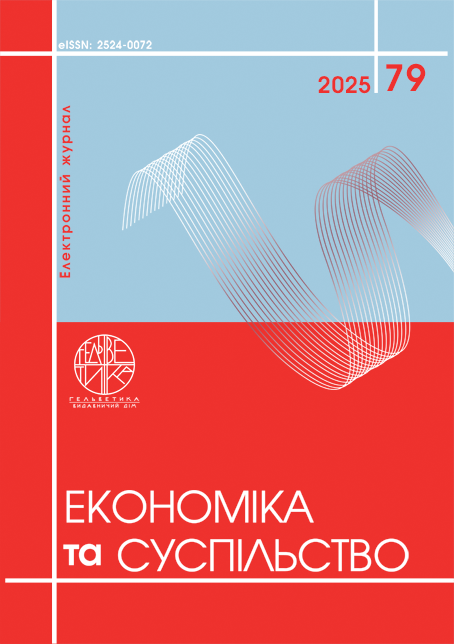GLOBAL DIFFUSION OF CRISIS PROCESSES AND SYNCHRONIZATION OF NATIONAL ECONOMIC CYCLES IN THE CONTEXT OF FINANCIAL GLOBALISM
Abstract
The global economic system has historically exhibited a cyclical nature marked by recurrent crisis phenomena, which reflect the inherent contradictions of the capitalist mode of production. These crises are manifested through deep structural disruptions across various subsystems of the world economy. This article investigates the essential nature and underlying drivers of global economic crisis dynamics at both the domestic and international levels. The analysis of the 2007-2009 global financial crisis substantiates its systemic and global character, given its scale, depth, trajectory, and widespread impact on national economies. The study demonstrates that the crisis activated a self-reinforcing mechanism of global diffusion of crisis processes and synchronization of national economic cycles, indicating a transformation in the cyclical regime of global economic reproduction. The article conceptualizes the forms of crisis cyclicality in the global economy and examines the mechanisms of transboundary crisis diffusion and cycle synchronization under conditions of financial globalization. The findings underscore the predominance of the financial transmission channel over the trade channel in propagating global crisis phenomena, interpreted through the theoretical framework of financial contagion. This study argues that, at the current stage of developing a post-neoliberal model of the global economic order, the worldwide diffusion of crisis phenomena and the synchronization of national economic cycles are generating a globally turbulent and crisis-prone environment that shapes the context of diplomatic activity within the economic sphere. Furthermore, the study outlines key vectors of transformation in national systems of economic diplomacy in the context of crisis-induced turbulence. It is argued that national foreign economic policies are undergoing significant structural adjustments, characterized by a transition from predominantly bilateral engagements to multidimensional models of multilateral economic coordination. The increasing relevance of the security dimension in diplomatic practice is emphasized, highlighting the emergence of crisis-responsive and resilience-oriented diplomacy as integral components of contemporary international economic relations.
References
Acharya V., Drechsler I., Schnabl P. A Pyrrhic Victory? Bank Bailouts and Sovereign Credit Risk. Journal of Finance. 2014. Vol. 69, No. 6. P. 2689-2739. URL: http://www.jstor.org/stable/43611079
Aruoba S. B., Diebold F. X., Kose M. A., Terrones M. E. Globalization, the Business Cycle, and Macroeconomic Monitoring. URL: https://www.elibrary.imf.org/view/journals/001/2011/025/article-A001-en.xml
Ayala-Canon L., Delgado-Rodriguez M. J., De Lucas-Santos S. Synchronization and cyclicality of social spending in economic crises. Empirica. 2022. Vol. 49. P. 1153-1187.
Erola P., Díaz-Guilera A., Gómez S., Arenas A. Modeling international crisis synchronization in the world trade web. Networks and Heterogeneous Media. 2012. Vol. 7, No. 3. P. 385-397. doi: 10.3934/nhm.2012.7.385
Forbes K., Rigobon R. No Contagion, Only Interdependence: Measuring Stock Market Comovements. Journal of Finance. 2002. Vol. 57, No. 5. P. 2223-2261. URL: https://www.jstor.org/stable/3094510
Grillini S., Ozkan A., Sharma A. Static and Dynamic Liquidity Spillovers in the Eurozone: The Role of Financial Contagion and the COVID-19 Pandemic. International Review of Financial Analysis. 2022. Vol. 83. URL: https://doi.org/10.1016/j.irfa.2022.102273
Grinin L., Korotaev A., Tausch A. Economic Cycles, Crises, and the Global Periphery. Cham: Springer International Publishing, 2016. 265 p. (International Perspectives on Social Policy, Administration, and Practice).
IMF Survey: When National Cycles Coincide: Tracking Global Recessions and Recoveries. IMF Survey. February 9, 2016. URL: https://www.imf.org/en/News/Articles/2015/09/28/04/53/soint020916a
Kaminsky G. L., Reinhart C. M. The Twin Crises: The Causes of Banking and Balance-of-Payments Problems. American Economic Review. 1999. Vol. 89, No. 3. P. 473-500. URL: https://doi.org/10.1257/aer.89.3.473
Laeven L., Valencia F. Systemic Banking Crises Database II. IMF Economic Review. 2020. Vol. 68. P. 307-361. URL: https://doi.org/10.1057/s41308-020-00107-3
Miranda-Agrippino S., Rey H. Chapter 1 – The Global Financial Cycle. Handbook of International Economics. 2022. Vol. 6. P. 1-43.
Monnet E., Puy D. Has globalization increased business cycle synchronization? Banque de France, 19 April 2017. URL: https://www.banque-france.fr/en/publications-and-statistics/publications/has-globalization-increased-business-cycle-synchronization
Pericoli M., Sbracia M. A Primer on Financial Contagion. Journal of Economic Surveys. 2003. Vol. 17, No. 4. P. 571-608. URL: https://doi.org/10.1111/1467-6419.00205
World Bank Indicators. URL: https://data.worldbank.org/indicator
File: Greece public debt 1999-2010.svg. Wikipedia. URL: https://en.wikipedia.org/wiki/File:Greece_public_debt_1999-2010.svg
Антициклічне регулювання ринкової економіки: глобалізаційна перспектива: монографія / Д. Г. Лук’яненко, А. М. Поручник, Я. М. Столярчук [та ін.]; за заг. ред. Д. Г. Лук’яненка, А. М. Поручника. – Київ: КНЕУ, 2010. – 334 с.
Гальчинський А. С. Економічна методологія. Логіка оновлення: Курс лекцій. Київ: АДЕФ-Україна, 2010. 572 с.
Найгучніші дефолти останнього двадцятиліття: Аргентина, Росія та реструктуризація боргу Греції. Тиждень. 28 травня 2015. URL: https://tyzhden.ua/najhuchnishi-defolty-ostannoho-dvadtsiatylittia-arhentyna-rosiia-ta-restrukturyzatsiia-borhu-hretsii/
Паламарчук М. В. Глобальний економічний цикл та синхронізація поточної світової рецесії. Економічний часопис – ХХІ. 2011. № 3-4. С. 24-27.
Acharya, V., Drechsler, I., & Schnabl, P. (2014). A Pyrrhic victory? Bank bailouts and sovereign credit risk. Journal of Finance, 69(6), 2689-2739. http://www.jstor.org/stable/43611079
Aruoba, S. B., Diebold, F. X., Kose, M. A., & Terrones, M. E. (2011). Globalization, the business cycle, and macroeconomic monitoring. International Monetary Fund. https://www.elibrary.imf.org/view/journals/001/2011/025/article-A001-en.xml
Ayala-Canon, L., Delgado-Rodriguez, M. J., & De Lucas-Santos, S. (2022). Synchronization and cyclicality of social spending in economic crises. Empirica, 49, 1153–1187. https://doi.org/10.1007/s10663-022-09561-0
Erola, P., Díaz-Guilera, A., Gómez, S., & Arenas, A. (2012). Modeling international crisis synchronization in the world trade web. Networks and Heterogeneous Media, 7(3), 385-397. https://doi.org/10.3934/nhm.2012.7.385
Forbes, K., & Rigobon, R. (2002). No contagion, only interdependence: Measuring stock market comovements. Journal of Finance, 57(5), 2223-2261. https://www.jstor.org/stable/3094510
Grillini, S., Ozkan, A., & Sharma, A. (2022). Static and dynamic liquidity spillovers in the Eurozone: The role of financial contagion and the COVID-19 pandemic. International Review of Financial Analysis, 83, Article 102273. https://doi.org/10.1016/j.irfa.2022.102273
Grinin, L., Korotaev, A., & Tausch, A. (2016). Economic cycles, crises, and the global periphery. Springer International Publishing. https://doi.org/10.1007/978-3-319-41262-7
International Monetary Fund (IMF). (2016, February 9). When national cycles coincide: Tracking global recessions and recoveries. https://www.imf.org/en/News/Articles/2015/09/28/04/53/soint020916a
Kaminsky, G. L., & Reinhart, C. M. (1999). The twin crises: The causes of banking and balance-of-payments problems. American Economic Review, 89(3), 473-500. https://doi.org/10.1257/aer.89.3.473
Laeven, L., & Valencia, F. (2020). Systemic banking crises database II. IMF Economic Review, 68, 307–361. https://doi.org/10.1057/s41308-020-00107-3
Miranda-Agrippino, S., & Rey, H. (2022). The global financial cycle. In G. Gopinath, E. Helpman, & K. Rogoff (Eds.), Handbook of International Economics (Vol. 6, pp. 1-43). Elsevier.
Monnet, E., & Puy, D. (2017, April 19). Has globalization increased business cycle synchronization? Banque de France. https://www.banque-france.fr/en/publications-and-statistics/publications/has-globalization-increased-business-cycle-synchronization
Pericoli, M., & Sbracia, M. (2003). A primer on financial contagion. Journal of Economic Surveys, 17(4), 571–608. https://doi.org/10.1111/1467-6419.00205
World Bank. (n.d.). World Bank indicators. https://data.worldbank.org/indicator
Wikipedia. (n.d.). Greece public debt 1999–2010 [SVG file]. https://en.wikipedia.org/wiki/File:Greece_public_debt_1999-2010.svg
Lukianenko, D. H., Poruchnyk, A. M., & Stoliarchuk, Ya. M. (Eds.). (2010). Antytsyklichne rehuliuvannia rynkovoi ekonomiky: Hlobalizatsiina perspektyva [Counter-cyclical regulation of the market economy: A globalization perspective]. KNEU.
Halchynskyi, A. S. (2010). Ekonomichna metodolohiia. Lohika onovlennia: Kurs lektsii [Economic methodology. Logic of renewal: Lecture course]. ADEF-Ukraina.
Tyzhden. (2015, May 28). Naighuchnishi defolty ostannoho dvadtsiatylittia: Arhentyna, Rosiia ta restrukturyzatsiia borhu Hretsii [The loudest defaults of the last two decades: Argentina, Russia, and Greece’s debt restructuring]. https://tyzhden.ua/najhuchnishi-defolty-ostannoho-dvadtsiatylittia-arhentyna-rosiia-ta-restrukturyzatsiia-borhu-hretsii/
Palamarchuk, M. V. (2011). Hlobalnyi ekonomichnyi tsykl ta synkhronizatsiia potochnoi svitovoi retsesii [The global economic cycle and the synchronization of the current global recession]. Ekonomichnyi chasopys – XXI, (3-4), 24-27.

This work is licensed under a Creative Commons Attribution 4.0 International License.


